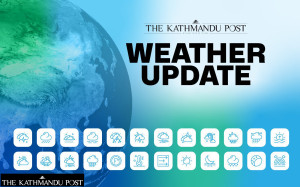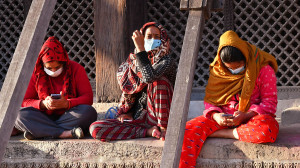Weather
Monsoon picks up, Nepal braces for impact
Authorities issue red, yellow, and orange alerts as rivers rise.
Post Report
With a low-pressure area shifting towards the north, the monsoon has become more active in Nepal, increasing the risk of monsoon-related disasters—landslides and inundation.
The flood forecasting division under the Department of Hydrology and Meteorology issued an orange alert for Kailali and Kanchanpur districts. Orange alert means the water level in the river will increase to a danger level and trigger a flood.
Likewise, a yellow alert has been issued for 36 districts, including all three districts of Kathmandu Valley—Kathmandu, Lalitpur, and Bhaktapur.
The yellow alert indicates that the risk is moderate, which means people residing or working near the river must be cautious.
“We have issued the warning as per the risk assessment,” said Dipesh Budhathoki, assistant hydrologist at the division. “We hope all agencies concerned and people take precautions to avoid the risks.”
The Meteorological Forecasting Division said that moderate rainfall is possible at some places in the hilly regions of Koshi, Lumbini, Karnali, and Sudurpaschim provinces and at certain areas in the rest of the provinces. Some areas of Koshi and Sudurpaschim provinces could also witness heavy rainfall.
Meanwhile, disaster data provided by the National Disaster Risk Reduction and Management Authority show that 77 people have succumbed to disaster-related incidents, including landslides, flooding, heavy rainfall, thunder strikes, fire, and snakebites, since April 14. Around 340 people have been injured in the incidents. Since the start of the monsoon on May 29, at least 47 people have died, and 19 others are missing.
Every year, hundreds of people die in monsoon-related incidents—landslides, floods, thunderstorms, snakebites, and several other communicable diseases.
Despite changing rainfall patterns caused by climate change—from extreme rainfall over short periods to prolonged dry spells—wreaking havoc across the country over a decade and a half, affecting thousands of people and threatening livelihoods, the working style of the agencies concerned has not changed significantly, according to experts.
This year, the Met Office has forecast above-normal monsoon rains, which could spell more disasters—flooding in the plains and flash floods and landslides in the hills and mountainous regions.
Nepal is one of the world’s most vulnerable countries to the climate crisis and has witnessed extreme weather events over the past decade and a half.
Evidence suggests that the maximum temperature in Nepal is rising at a greater rate (0.056 degrees Celsius per year) than the global average of 0.03 degrees Celsius per year.
Experts say extreme weather events—excess rainfall in a short period, continuous rains for several days after the monsoon, dry spells, droughts, below-average precipitation, and above-normal winter temperatures—have become more frequent in Nepal.
The monsoon, which usually runs from June 13 to September 23 and delivers around 80 percent of the country’s total annual rainfall over 105 days, has lingered longer than usual in recent years.




 9.12°C Kathmandu
9.12°C Kathmandu



%20(1).jpg&w=300&height=200)

